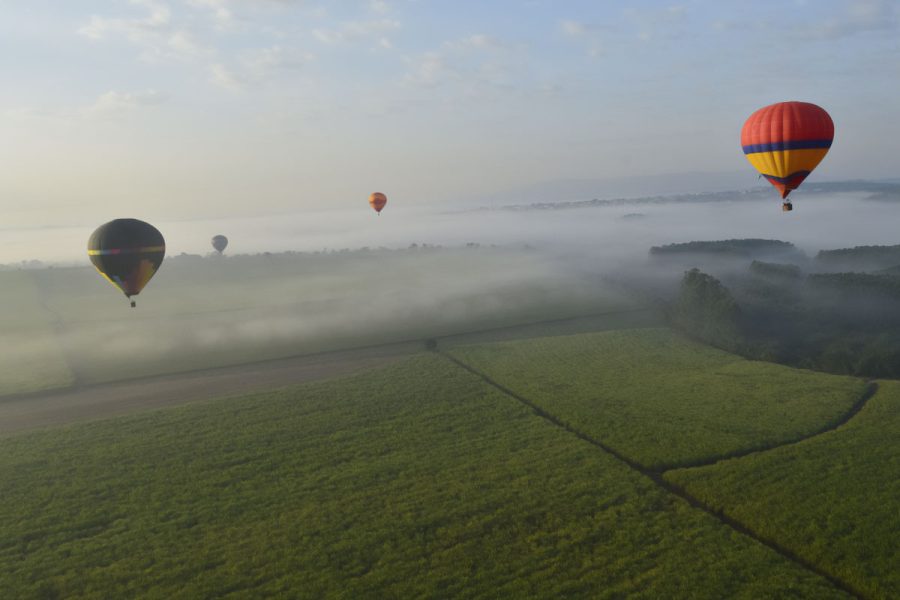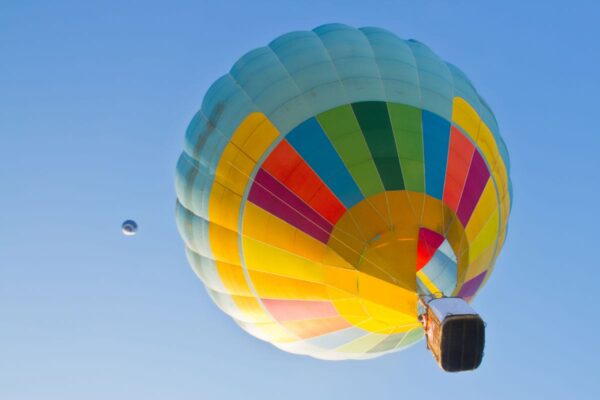A hot air balloon flight is one of the most magical experiences. The peaceful drifting over the landscape evokes fairy tale adventures. However, behind this apparent ease lies the precise knowledge of the pilots. Passenger safety depends on the conscious choice of appropriate weather conditions.
Weather conditions have a crucial impact on flight safety. Experienced pilots analyze every meteorological detail. Temperature, humidity, wind speed, and atmospheric pressure determine the possibility of takeoff. Professional companies organize flights only when the weather favors a safe journey.
Minimum Weather Requirements for a Safe Balloon Takeoff
A safe balloon takeoff requires meeting strict meteorological criteria. Experienced pilots check forecasts several days in advance. The decision to fly is made only after a detailed analysis of conditions.
Wind Speed Near the Ground
Wind at ground level must not exceed specified limits. A safe takeoff requires wind speeds below 10 km/h. Stronger gusts can make controlling the balloon during takeoff difficult. Pilots check wind conditions using specialized instruments. An anemometer shows the exact speed in real time.
Wind direction is equally important. A steady direction facilitates flight path planning. Variable gusts can cause balloon instability. Professional pilots cancel flights during sudden changes in wind direction.
Atmospheric Stability
The atmosphere must be stable throughout the planned flight. Sudden pressure changes pose danger. A weather front can cause abrupt deterioration of conditions. Pilots analyze synoptic maps before each flight.
Thermals, or vertical air movements, affect flight comfort. Moderate thermals provide stable lift. Too strong updrafts can be unpleasant for passengers. Experienced pilots choose times with the weakest thermal activity.
Air Temperature and Gradients
Temperature differences between the earth’s surface and higher layers affect the flight:
- Ground temperature – optimal from 15°C to 25°C
- Temperature gradient – decrease of 6°C per 1000 meters altitude
- Temperature inversion – conditions favoring stable flight
- Surface heating – can cause strong thermals
- Nocturnal cooling – creates favorable morning conditions
Temperature affects air density inside the balloon. Cold external air increases lift force. Warm days require more heating of the envelope. Pilots consider temperature when calculating takeoff weight.
Tip: The best flying conditions occur in the morning when temperature is stable and thermals have not yet developed their activity.
Optimal Wind Speed and Its Impact on Balloon Flight
Wind speed is a fundamental factor for balloon flight safety. The balloon moves with the air mass. Pilots do not control horizontal flight direction. Therefore, wind conditions require special attention.
Wind Near Ground Level
Takeoff and landing are the most critical moments of the flight. Wind near the ground must not exceed 15 km/h. Higher speeds make controlling the balloon difficult. The basket may tilt during contact with the ground.
Professional pilots use handheld anemometers. They take measurements just before takeoff. Conditions can change even within a few minutes. The decision to cancel the flight is made immediately if limits are exceeded.
Wind at flight altitude
Wind conditions change with altitude. Pilots analyze the wind profile up to 3000 meters. Different atmospheric layers can have varying directions. This knowledge helps in planning the flight route.
Stable wind at altitude ensures a smooth journey. Sudden changes in speed can be felt in the basket. Turbulence occurs with large differences in wind profiles. Experienced pilots choose layers with the most stable conditions.
Safe wind speeds for different phases of flight:
- Balloon takeoff – maximum 10 km/h near the ground
- Flight at altitude – up to 30 km/h in a stable direction
- Landing – no more than 15 km/h near the surface
- Balloon packing – below 20 km/h for crew safety
The wind direction is crucial for safety. The pilot plans the route based on weather forecasts. A change in direction during flight may require plan adjustments. Experience allows predicting wind behavior.
Tip: The most favorable wind conditions occur in the morning and evening, when thermal activity is minimal and the wind has a stable direction.
Air temperature and balloon performance and safety
Temperature plays a key role in balloon flight physics. Warm air inside the envelope is lighter than the surrounding air. This density difference creates lift force. Pilots must carefully control temperature throughout the flight.
The impact of external temperature
The ambient temperature affects heater performance. On cold days, the temperature difference is greater. The balloon rises more easily at low external temperatures. Hot days require more intensive heating of the envelope.
The optimal external temperature ranges from 5°C to 20°C. Extreme temperatures pose additional challenges. Frost can affect instrument operation. Heat increases the risk of overheating the heater engine.
Temperature gradient in the atmosphere
Temperature decreases with flight altitude. The standard gradient is about 6°C per 1000 meters. This rule helps pilots plan fuel consumption. Nonstandard gradients may indicate an unstable atmosphere.
A temperature inversion is a phenomenon beneficial for flights. Warmer air at altitude creates a stable layer. The balloon maintains a steady height more easily. Pilots seek such conditions for a comfortable flight.
Temperature control inside the envelope
The pilot controls temperature using a gas burner. Regular reheating maintains lift force. Overheating of the envelope can be dangerous. The fabric temperature must not exceed 120°C.
Modern balloons have temperature control systems. Sensors inform the pilot about the envelope temperature. Automatic systems warn against overheating. Passenger safety is always the highest priority.
Tip: Pilots of professional companies monitor the envelope temperature throughout the flight, using advanced control systems and their own experience in assessing thermal conditions.
Professional Balloon Flights with ProBallooning
ProBallooning is a company founded by experienced pilots passionate about flying. The founder has over eight years of experience in ballooning and has completed more than 500 flights. The company specializes in organizing safe balloon flights for civilian passengers.
Experience and Certifications
ProBallooning pilots are active members of balloon clubs. The founder is a member of the Polish National Team for gas balloon flights. He regularly participates in competitions at the Polish and World Championship levels. Such sporting experience translates into the highest level of safety for commercial flights.
All balloons hold European Union safety certificates. The equipment undergoes regular technical inspections according to regulations. The company conducts flights only in favorable weather conditions. Passenger safety takes absolute priority over completing scheduled flights.
Flight Offerings and Services
Types of flights available at ProBallooning:
Each flight lasts about an hour in the air. The entire experience takes 3-4 hours. Passengers participate in preparing the balloon for takeoff. After landing, there is a traditional toast and presentation of the Aeronaut certificate.
Customer Reviews and Service Quality
ProBallooning enjoys excellent customer reviews. The company has received a 5.0 rating based on over 200 positive reviews. Passengers highlight the professionalism of the crew and unforgettable experiences. The well-organized event is especially praised.
Customers appreciate the opportunity to participate in balloon preparations. Transportation to the launch site and return is provided. Photographic documentation of the flight captures special moments. The company also provides insurance for all flight participants.
ProBallooning offers the possibility to change the flight date without additional fees in case of unfavorable weather conditions, ensuring a safe experience.
Atmospheric Visibility as a Key Element of Safe Navigation
Visibility in the air is fundamental for flight safety. The pilot must see the terrain, obstacles, and other aircraft. The minimum horizontal visibility is 5 kilometers. In mountainous areas, the requirements are even more stringent.
Factors Affecting Visibility
Fog is the greatest threat to visibility. It forms with high humidity and cooling air. Morning fog often hinders balloon takeoffs. Pilots cancel flights when visibility falls below safe limits.
Smoke, smog, and dust also reduce visibility. Industrial areas can pose problems for aviation. Natural phenomena like sandstorms are rare in Poland. However, pilots always check current weather conditions.
Vertical Visibility
The cloud base must be sufficiently high. The minimum height is 300 meters above ground level. Low clouds limit maneuvering options. The pilot needs freedom to choose flight altitude.
Cumulus clouds indicate an unstable atmosphere. They can develop into stormy cumulonimbus clouds. Experienced pilots avoid such conditions. A safe flight requires a stable cloud layer or clear skies.
Navigation Instruments
Modern balloons are equipped with advanced navigation systems:
- GPS – precise position determination
- Altimeter – flight altitude control
- Vertical speed indicator – measurement of vertical speed
- Radio station – communication with air traffic control
- Electronic map – flight route planning
The instruments assist the pilot but do not replace eyesight. Terrain observation remains crucial for safety. The pilot must see the landing site from a sufficient distance. Planning alternative routes requires good visibility.
Tip: Before each flight, pilots check current meteorological reports regarding visibility and analyze forecasts for the upcoming hours to ensure safe conditions throughout the flight.
Dangers Related to Rain and Snow During Flight
Precipitation poses a serious threat to balloon flights. Water increases the mass of the balloon envelope. Wet fabric loses some of its properties. Pilots never take off during active rain or snow.
The Impact of Rain on Flight
Rain significantly increases the balloon’s weight. A few liters of water per square meter of fabric have a substantial effect. The balloon becomes heavier and harder to control. The wet envelope takes longer to dry after landing.
Heavy rain limits pilot visibility. Drops on goggles hinder terrain observation. Water can get into the balloon basket. Passenger comfort deteriorates significantly under such conditions.
Dangers Related to Snow
Snow is even more problematic than rain. A snowstorm drastically reduces visibility. The pilot can lose spatial orientation. Low temperatures further complicate the situation.
Snow accumulating on the envelope increases the balloon’s weight. Melting snow turns into ice. Icing can damage the delicate fabric. Low temperatures affect the operation of instruments.
Weather Planning
Weather factors analyzed before each flight:
- Precipitation forecast – probability of rain or snow
- Precipitation intensity – amount in mm/h during the forecasted time
- Duration – length of the precipitation period
- Temperature – risk of icing during precipitation
- Wind – possibility of precipitation being carried from neighboring areas
Professional pilots analyze forecasts from multiple sources. Weather radars show current precipitation. Numerical models predict the development of the situation. The decision to cancel a flight is made early for passenger comfort.
Tip: Balloon flights are planned only during periods without atmospheric precipitation, so companies offer flexible dates and the option to reschedule flights to a more favorable day.
Why Balloon Flights Mainly Take Place at Sunrise and Sunset
The timing of balloon launches is not accidental. The rising and setting sun create optimal atmospheric conditions. Air stability at these times ensures a comfortable flight. Most professional companies organize flights exclusively at these times.
Atmospheric Stability
During sunrise, the atmosphere is most stable. The air has cooled overnight. Thermal activity has not yet developed. The absence of strong updrafts ensures a calm flight.
Sunset is the second optimal time. The earth’s surface begins to cool. Thermal activity gradually weakens. Evening conditions are often more stable than morning ones. Pilots prefer launches 2-3 hours before sunset.
Wind Conditions
The wind is usually weakest in the morning throughout the day. The earth’s surface and air have similar temperatures. Lack of significant temperature differences means light wind. Ideal conditions for safe takeoff and landing.
The wind also calms down in the evening after an active day. Temperature gradients even out before nightfall. Stable wind conditions persist until dusk. Pilots finish flights before complete darkness falls.
Operational Safety
Advantages of flights during optimal times of day:
- Minimal thermal activity – calm, comfortable flight
- Light wind – easy takeoffs and landings
- Good visibility – safe navigation
- Stable atmosphere – predictable conditions
- Passenger comfort – pleasant experience
Noon flights are much more challenging. Strong thermal activity causes turbulence. The balloon may rise or descend abruptly. Passengers experience discomfort during such flights. Professional pilots avoid these conditions.
Sunrises and sunsets offer the most beautiful views. Golden light creates a magical atmosphere. Shadows emphasize terrain features. Photographers especially value these times of day.
Soft light in the morning and evening is pleasant for the eyes. The sun does not blind the pilot or passengers. The contrasts are natural and friendly. The entire experience becomes more exceptional.
Tip: When planning a balloon flight, be prepared for a very early morning or evening start, as these times of day guarantee the safest and most beautiful experience.
Summary
A safe balloon flight requires meeting strict weather criteria. Wind speed, temperature, visibility, and no precipitation are basic requirements. Professional pilots analyze conditions from multiple sources before every decision to take off.
The optimal flight times are sunrise and sunset, when the atmosphere is most stable. ProBallooning follows all safety rules, offering unforgettable experiences in controlled conditions. Flexible scheduling allows flights to be rescheduled in unfavorable weather, ensuring every passenger a safe journey over Poland’s picturesque landscapes.





